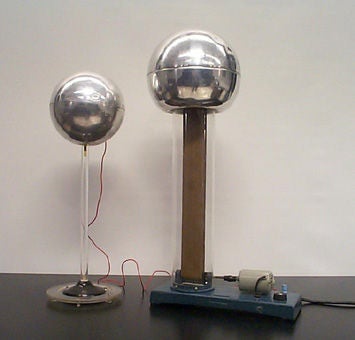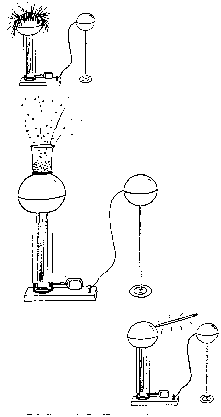-
It is a source of high-voltage static electricity, quickly producing up to 250,000 V. The large (about 25 cm in diameter) charge sphere is mounted in a Lucite support column, which allows the students to see the belt-driven charging system in action. The belt runs between two pulleys, the lower one connected to a driven motor. Two metallic combs, one in each end of the belt, complete the charging mechanism. The pulleys are of different materials: the lower one induces negative charges on the belt and the upper one induces positive charges. The negative charges travel up on the belt until the upper metallic comb where the negative charges are transferred to the comb and then to the metallic sphere. The air between the belt and the comb is ionized. When the belt leaves the upper pulley, it carries positive charges that will be transferred to the lower comb and to the ground.

The electric potential of the large sphere increases until the air’s point of breakdown is reached, then it discharges through the air to the other aluminum sphere (20 cm in diameter) mounted on a Lucite rod and grounded through the generator’s metal base. Under favorable conditions, it produces up to 250,000 V.

-
The static electricity generated by the Van de Graaff generator can also be exhibited with the following procedures:
Arrange a wig over the generator’s sphere or ask a volunteer to stand on an insulated platform and touch the generator’s sphere; the person’s hair or wig’s will stand up into the air
Place an insulated beaker filled of little Styrofoam balls on top of the generator’s sphere — the balls will flow out and up into the air
A piece of wire is bent in the shape of a ring with a small tip to the side. Place it on top of the generator’s sphere and turn on the generator. It will not spark regardless of how close the discharging sphere is! The piece of wire that protrudes dissipates the charge before it accumulates on the sphere
A small cylinder (8 cm tall and 8 cm in diameter) with clear plastic walls and metallic top has a small amount of tiny pieces of light-weight material. When connected to the Van de Graaff generator, the material inside it will bounce around rapidlyAll the accessories listed after the Wimshurst machine can also be used to illustrate electrostatic behavior together with the Van de Graaff generator.


-
This battery-powered wand features a mini Van de Graaff generator inside. Push a button on the handle and static charges build up in the wand. This causes various 3D Mylar shapes to levitate at your command. You can also do some cool tricks causing the shapes to jump back and forth from your hand to the wand. It’s not magic…it’s physics!
Click here to see a video of the Levitation Wand demo.


Van De Graaff Generator
Contact our lab
Visit Us
USC Physics Lecture Support Lab SLH (Stauffer Lecture Hall) – 104
Department of Physics and Astronomy
University of Southern California
Los Angeles
Questions or Comments
If you have questions or comments e-mail us or call at phone number below.